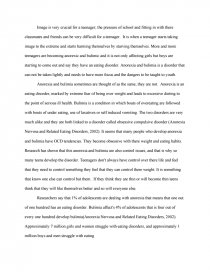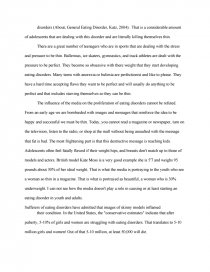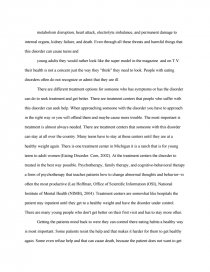Eating Disordes
Essay by review • February 18, 2011 • Essay • 1,440 Words (6 Pages) • 1,209 Views
Image is very crucial for a teenager; the pressure of school and fitting in with there classmates and friends can be very difficult for a teenager. It is when a teenager starts taking image to the extreme and starts harming themselves by starving themselves. More and more teenagers are becoming anorexic and bulimic and it is not only affecting girls but boys are starting to come out and say they have an eating disorder. Anorexia and bulimia is a disorder that can not be taken lightly and needs to have more focus and the dangers to be taught to youth.
Anorexia and bulimia sometimes are thought of as the same, they are not. Anorexia is an eating disorder, marked by extreme fear of being over weight and leads to excessive dieting to the point of serious ill health. Bulimia is a condition in which bouts of overeating are followed with bouts of under eating, use of laxatives or self induced vomiting. The two disorders are very much alike and they are both linked to a disorder called obsessive compulsive disorder (Anorexia Nervosa and Related Eating Disorders, 2002). It seems that many people who develop anorexia and bulimia have OCD tendencies. They become obsessive with there weight and eating habits. Research has shown that this anorexia and bulimia are also control issues, and that is why so many teens develop the disorder. Teenagers don't always have control over there life and feel that they need to control something they feel that they can control there weight. It is something that know one else can control but them. If they think they are thin or will become thin teens think that they will like themselves better and so will everyone else.
Researchers say that 1% of adolescents are dealing with anorexia that means that one out of one hundred has an eating disorder. Bulimia affect's 4% of adolescents that is four out of every one hundred develop bulimia(Anorexia Nervosa and Related Eating Disorders, 2002). Approximately 7 million girls and women struggle with eating disorders, and approximately 1 million boys and men struggle with eating
disorders (About, General Eating Disorder, Katz, 2004). That is a considerable amount of adolescents that are dealing with this disorder and are literally killing themselves thin.
There are a great number of teenagers who are in sports that are dealing with the stress and pressure to be thin. Ballerinas, ice skaters, gymnastics, and track athletes are dealt with the pressure to be perfect. They become so obsessive with there weight that they start developing eating disorders. Many teens with anorexia or bulimia are perfectionist and like to please. They have a hard time accepting flaws they want to be perfect and will usually do anything to be perfect and that includes starving themselves so they can be thin.
The influence of the media on the proliferation of eating disorders cannot be refuted. From an early age we are bombarded with images and messages that reinforce the idea to be happy and successful we must be thin. Today, you cannot read a magazine or newspaper, turn on the television, listen to the radio, or shop at the mall without being assaulted with the message that fat is bad. The most frightening part is that this destructive message is reaching kids. Adolescents often feel fatally flawed if their weight hips, and breasts don't match up to those of models and actors. British model Kate Moss is a very good example she is 5'7 and weighs 95 pounds about 30% of her ideal weight. That is what the media is portraying to the youth who see a woman so thin in a magazine. That is what is portrayed as beautiful, a woman who is 30% underweight. I can not see how the media doesn't play a role in causing or at least starting an eating disorder in youth and adults.
Sufferers of eating disorders have admitted that images of skinny models inflamed
their condition. In the United States, the "conservative estimates" indicate that after puberty, 5-10% of girls and women are struggling with eating disorders. That translates to 5-10 million girls and women! Out of that 5-10 million, at least 50,000 will die.
Many people would say that anorexia and bulimia starts at home and has nothing to do with all the images that teens see in the magazines and on the TV. Parents should be watching there a child's eating habits and they are to blame.
Eating disorders can start in the home. Most children are living in a home with at least one parent that is dieting (NEDIC, 2004). That is a major impact on a child; they are watching a parent obsess about their weight. Children want to be like their parents, they learn behaviors from their parents and that includes eating habits. Parents sometimes pressure children to be thin, maybe for sports reason or image but they can contribute to the problem if they are obsessive with their children and their weight.
There are signs that parents need to beware of and look for. Some of the signs are frequent picking at their food, missing meal time, going to the bathroom after a meal, running the water while they are in the bathroom, going on diets, taking diet pills and any other sign of food habit change. IF parents
...
...




